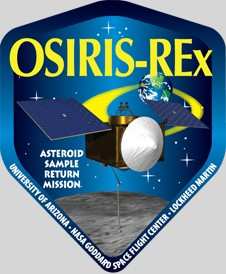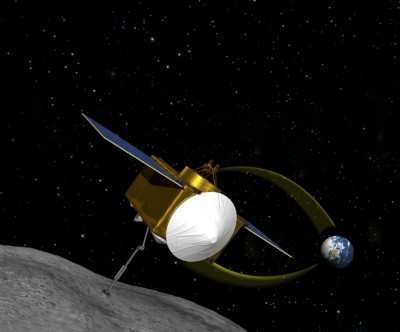Goal Is To Bring Samples Of The Asteroid Back To Earth
NASA will launch a spacecraft to an asteroid in 2016 and use a
robotic arm to pluck samples that could better explain our solar
system's formation and how life began. The mission, called
Origins-Spectral Interpretation-Resource
Identification-Security-Regolith Explorer, or OSIRIS-REx, will be
the first U.S. mission to carry samples from an asteroid back to
Earth.

"This is a critical step in meeting the
objectives outlined by President Obama to extend our reach beyond
low-Earth orbit and explore into deep space," said NASA
Administrator Charlie Bolden. "It's robotic missions like these
that will pave the way for future human space missions to an
asteroid and other deep space destinations."
NASA selected OSIRIS-REx after reviewing three concept study
reports for new scientific missions, which also included a sample
return mission from the far side of the moon and a mission to the
surface of Venus. Asteroids are leftovers formed from the cloud of
gas and dust -- the solar nebula -- that collapsed to form our sun
and the planets about 4.5 billion years ago. As such, they contain
the original material from the solar nebula, which can tell us
about the conditions of our solar system's birth.
After traveling four years, OSIRIS-REx will approach the
primitive, near Earth asteroid designated 1999 RQ36 in 2020. Once
within three miles of the asteroid, the spacecraft will begin six
months of comprehensive surface mapping. The science team then will
pick a location from where the spacecraft's arm will take a sample.
The spacecraft gradually will move closer to the site, and the arm
will extend to collect more than two ounces of material for return
to Earth in 2023. The mission, excluding the launch vehicle, is
expected to cost approximately $800 million.
The sample will be stored in a capsule that will land at Utah's
Test and Training Range in 2023. The capsule's design will be
similar to that used by NASA's Stardust spacecraft, which returned
the world's first comet particles from comet Wild 2 in 2006. The
OSIRIS-REx sample capsule will be taken to NASA's Johnson Space
Center in Houston. The material will be removed and delivered to a
dedicated research facility following stringent planetary
protection protocol. Precise analysis will be performed that cannot
be duplicated by spacecraft-based instruments.

Artist's Rendering
RQ36 is approximately 1,900 feet in diameter or roughly the size
of five football fields. The asteroid, little altered over time, is
likely to represent a snapshot of our solar system's infancy. The
asteroid also is likely rich in carbon, a key element in the
organic molecules necessary for life. Organic molecules have been
found in meteorite and comet samples, indicating some of life's
ingredients can be created in space. Scientists want to see if they
also are present on RQ36.
"This asteroid is a time capsule from the birth of our solar
system and ushers in a new era of planetary exploration," said Jim
Green, director, NASA's Planetary Science Division in Washington.
"The knowledge from the mission also will help us to develop
methods to better track the orbits of asteroids."
The mission will accurately measure the "Yarkovsky effect" for
the first time. The effect is a small push caused by the sun on an
asteroid, as it absorbs sunlight and re-emits that energy as heat.
The small push adds up over time, but it is uneven due to an
asteroid's shape, wobble, surface composition and rotation. For
scientists to predict an Earth-approaching asteroid's path, they
must understand how the effect will change its orbit. OSIRIS-REx
will help refine RQ36's orbit to ascertain its trajectory and
devise future strategies to mitigate possible Earth impacts from
celestial objects.
Michael Drake of the University of Arizona in Tucson is the
mission's principal investigator. NASA's Goddard Space Flight
Center in Greenbelt, Md., will provide overall mission management,
systems engineering, and safety and mission assurance. Lockheed
Martin Space Systems in Denver will build the spacecraft. The
OSIRIS-REx payload includes instruments from the University of
Arizona, Goddard, Arizona State University in Tempe and the
Canadian Space Agency. NASA's Ames Research Center at Moffett
Field, Calif., the Langley Research Center in Hampton, Va., and the
Jet Propulsion Laboratory in Pasadena, Calif., also are involved.
The science team is composed of numerous researchers from
universities, private and government agencies.

This is the third mission in NASA's New Frontiers Program. The
first, New Horizons, was launched in 2006. It will fly by the
Pluto-Charon system in July 2015, then target another Kuiper Belt
object for study. The second mission, Juno, will launch in August
to become the first spacecraft to orbit Jupiter from pole to pole
and study the giant planet's atmosphere and interior. NASA's
Marshall Space Flight Center in Huntsville, Ala., manages New
Frontiers for the agency's Science Mission Directorate in
Washington.
 ANN's Daily Aero-Linx (04.15.24)
ANN's Daily Aero-Linx (04.15.24) Classic Aero-TV: 'No Other Options' -- The Israeli Air Force's Danny Shapira
Classic Aero-TV: 'No Other Options' -- The Israeli Air Force's Danny Shapira Aero-News: Quote of the Day (04.15.24)
Aero-News: Quote of the Day (04.15.24) Airborne 04.16.24: RV Update, Affordable Flying Expo, Diamond Lil
Airborne 04.16.24: RV Update, Affordable Flying Expo, Diamond Lil ANN's Daily Aero-Term (04.16.24): Chart Supplement US
ANN's Daily Aero-Term (04.16.24): Chart Supplement US





